The 16th International Zurich Symposium and
Technical Exhibition on Electromagnetic Compatibility (EMC Zurich
’05) was again held at the Swiss Federal Institute of Technology
(ETH) in Zurich, Switzerland, February 13–18, 2005. The Symposium
took place in the main building of the Swiss Federal Institute
of Technology, which offered an impressive surrounding, convenient
conference facilities and easy access to the city of Zurich. The
event was organized by the Laboratory for Electromagnetic Fields
and Microwave Electronics under the sponsorship of Electrosuisse.
In contrast to previous years, this time the symposium covered
a full week of workshops, tutorials, topical meetings and –
as the core event – three days of EMC sessions. The exhibition
was organized in the gymnasium of the ETH, which provided about
1000 m2 of floor space to 39 exhibitors. Compared to EMC Zurich
‘03, the attendance rate of 550 participants from 40 countries
was about 15% higher. This, and the presence of the many national
and international cooperating organizations like the IEEE EMC
Society, URSI, and the IEE, as well as others, made this a truly
international event.
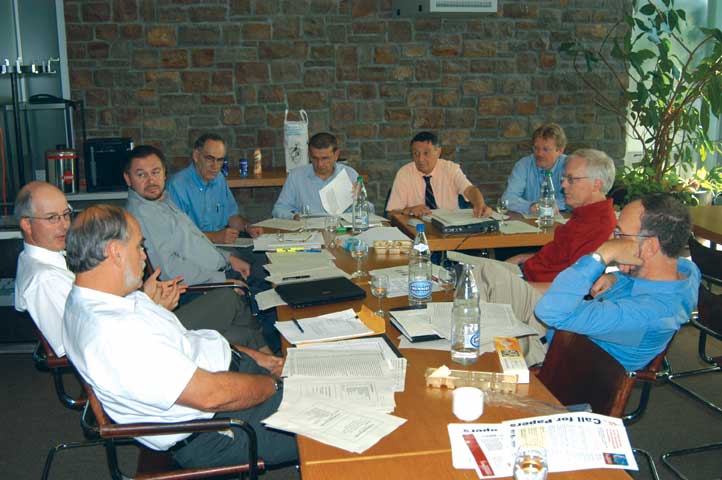 |
| The Technical Program Committee (TPC)
is shown hard at work just prior to EMC Zurich. |
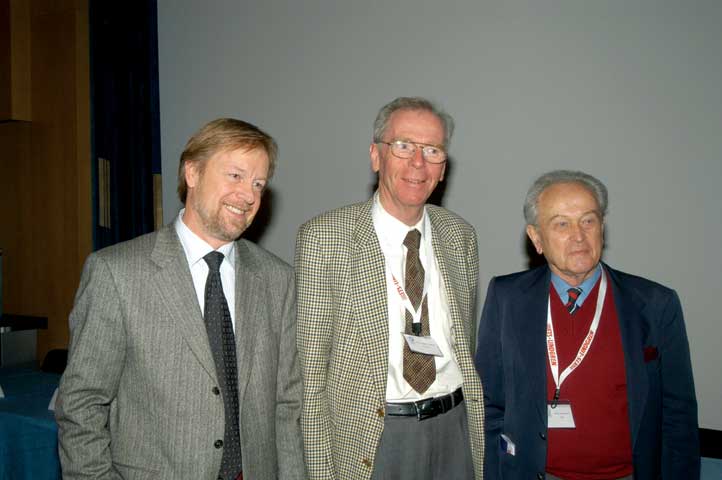 |
| Three generations of EMC Zurich Presidents
gathered in 2005, including (from left) Ruediger Vahldieck,
Peter Leuthold, and Thomas Dvorak. |
Prof. R. Vahldieck, Symposium President, chaired
the opening ceremony on Tuesday morning. He outlined the future
plans of EMC Zurich and highlighted the fact that EMC Zurich,
as one of the best and well-known EMC symposia in the world, will
also be held in the future at other locations, not just Zurich.
The rationale behind this move is to enable other countries and
regions to also participate more actively in EMC Zurich than was
possible in the past. In this context, he announced the 17th EMC
Zurich Symposium to be held in Singapore in 2006 (February 28–March
3, 2006) and introduced the president for that symposium, Dr.
Erping Li.
Year 2005 coincides with the 150th anniversary of the ETH Zurich,
and several speakers highlighted the long tradition of research
excellence at the ETH Zurich. Vice-President Research (ETH) Prof.
U. Suter, Prof. T. Hubing and Dr. L. Kueng addressed the audience
on behalf of the ETH administration, the IEEE EMC Society, and
the City of Zurich, respectively. The highlight of the opening
ceremony was the keynote speech given by Dr. M. Marcus, formerly
with the Federal Communications Commission and currently a visiting
researcher at the Ecole Nationale Supérieure des Télécommunications,
who spoke on how “EMC Paints the Lane Markings on the Wireless
Information Highway.”
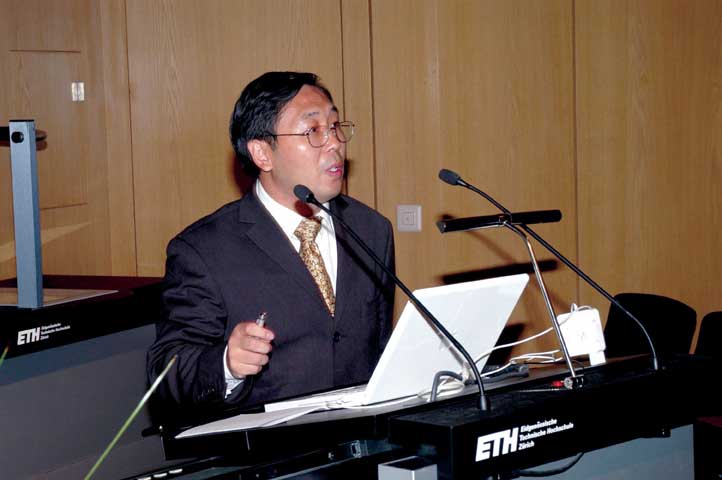 |
| The President of EMC Zurich in Singapore
2006, Erping Li, addressed the audience during the opening
ceremony. |
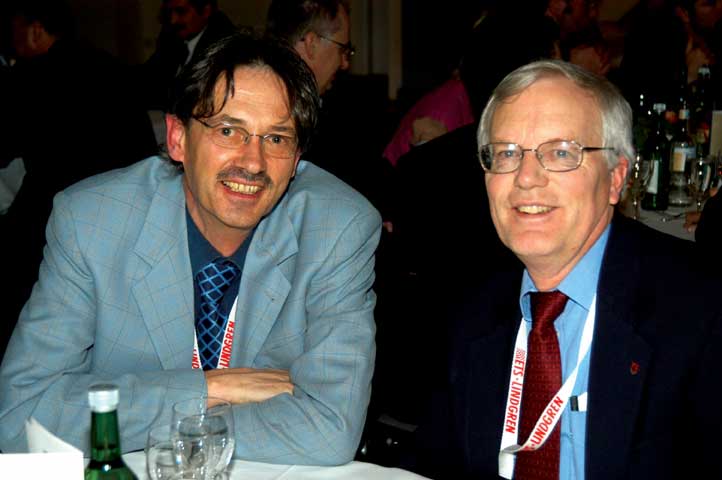 |
| The EMC Zurich 2005 Technical Program
Committee Co-Chairmen included Pascal Leuchtmann of ETH Zurich
(left) and Bob Olsen of Washington State University. |
Despite the continuing difficult economical
environment, paper submissions were almost at the customary level.
From the total of 191 submissions, 121 were accepted and presented
in 23 sessions covering a broad range of areas in the field of
electromagnetic compatibility. In addition, the pre-program two
days before the opening of the symposium offered tutorials meant
to serve as primers for important upcoming issues in EMC. Three
tutorials were held on Modeling and Simulation of Electromagnetic
Fields, while another dealt with SAR in Human Organs. All four
tutorials showed a high attendance rate, underlining their relevance
and importance to the EMC community. Parallel to the tutorial
session, six workshops were held on Field-Based Synthesis and
Computer Aided Design of Electromagnetic Structures, Field Strength
Meters/Radiation Monitors, Advances in Site Validation Techniques
above 1 GHz, Automotive EMC Simulation, EMC for IC and State-of-the-Art
of E-Safety Technology on Vehicles. In spite of tight scheduling,
all six topics drew large audiences and at times intense discussions
evolved.
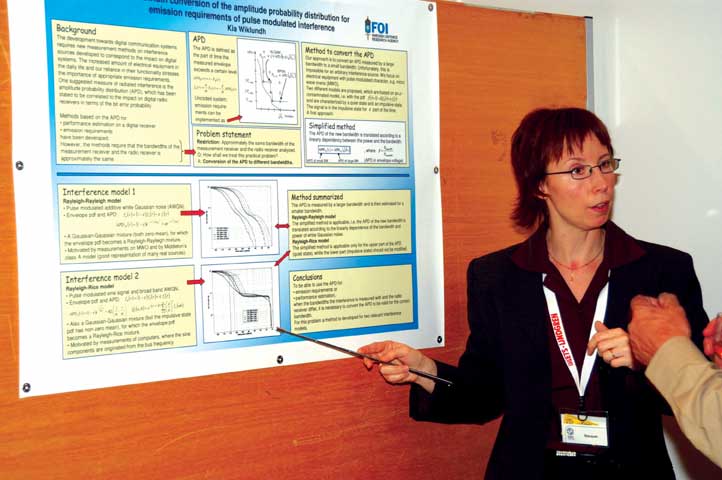 |
| The Student Prize Winner (2nd place)
at EMC Zurich, Ms. Kia Wiklundh. |
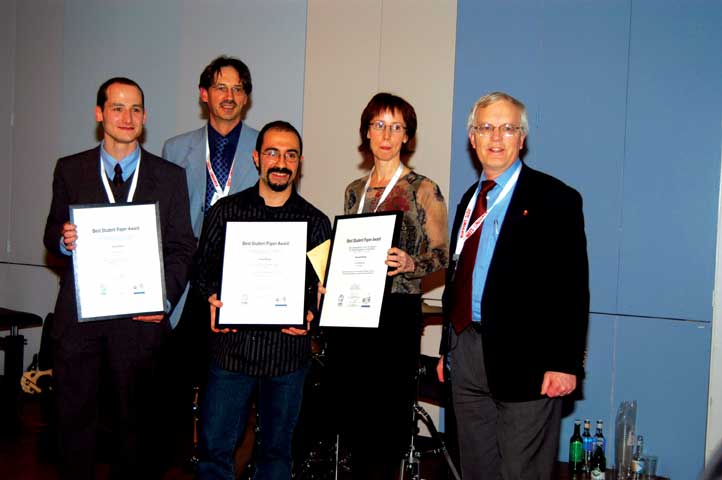 |
| The Best Student Paper Award Winners
at EMC Zurich, including (from left) Sven Battermann (3rd
place), Pascal Leuchtmann, (TPC Co-Chair), Luca Antonio de
Michele (1st place), Kia Wiklundh (2nd place) and Bob Olsen,
(TPC Co-Chair). |
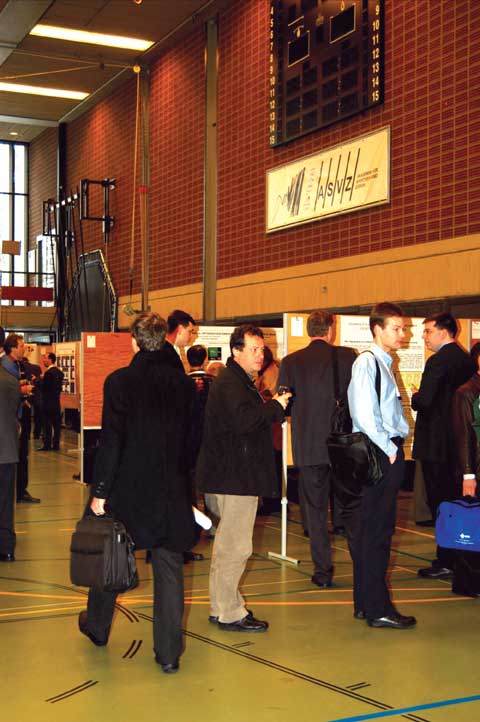 |
| The poster sessions at EMC Zurich
drew a lively audience. |
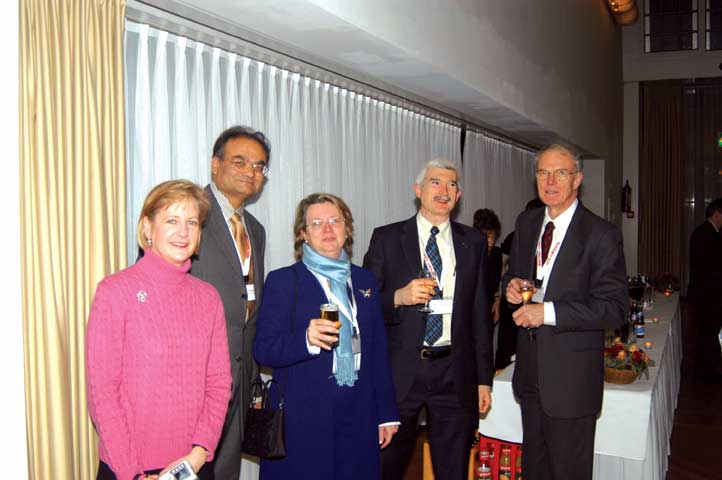 |
| Janet O’Neil of ETS-Lindgren,
Tapan Sarkar of Syracuse University, Magdalena Salazar-Palma
of Universidad Politecnica de Madrid, Elya Joffe of KTL Project
Engineering in Isreal, and John Norgard of the University
of Colorado at Colorado Springs (from left) appreciated the
international contributions to EMC Zurich. |
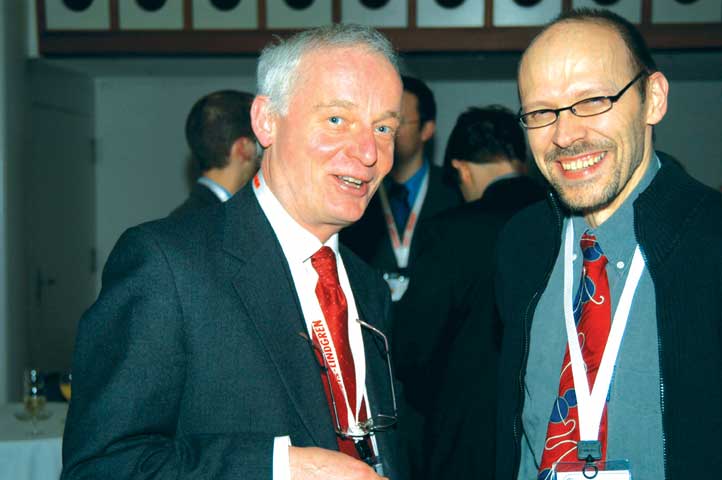 |
| Andy Marvin from the University of
York, UK (left) visited with his part time graduate student,
Jari Jekkonen of Nokia Finland, during EMC Zurich. |
Parallel with the symposium sessions, three
topical meetings were held: One on Reverberation Chambers with
10 contributions; one on Biomedical EMC with 30 papers; and last
but not least, in the COST 281 Meeting, the question of “Make
sinusoidal versus non-sinusoidal wave forms a difference?”
was discussed mainly with regard to biological effects.
The papers in the 23 symposium sessions covered a wide variety
of EMC issues. The technical program committee, co-chaired by
Prof. Dr. R. Olsen and Dr. P. Leuchtmann, as well as over 200
reviewers from all over the world, did a great job selecting the
best papers and grouping them as well as possible into the appropriate
sessions. Besides the more traditional EMC topics, papers on bio-electromagnetics,
EMC innovation and automotive EMC attracted large audiences. It
is interesting to note that numerical modeling of electromagnetic
fields is increasingly becoming a central tool in many areas of
EMC. In addition to the aforementioned tutorials on Modeling and
Simulation of Electromagnetic Fields, two sessions were devoted
to Computational Electromagnetics. The computation of electromagnetic
fields was also a central topic in the sessions on Chip and Package
Level EMC, EMC in Communications, Chip Level EMC, System Level
EMC and Automotive EMC. The complexity of modern EMC structures
makes model order reduction techniques and other mathematical
techniques important enablers in EMC simulations. Without these
techniques, the computational space for many EMC problems will
soon become too large for mainframe computers, not to mention
of workstation and personal computers.
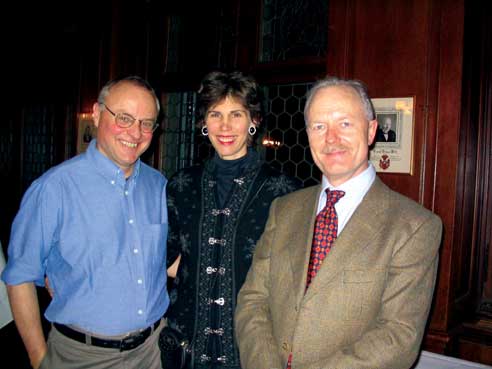 |
| Perry Wilson of NIST (left) brought
along his lovely wife Kay to one of the EMC Zurich social
events. They are joined by Heinz Wipf of Skyguide. |
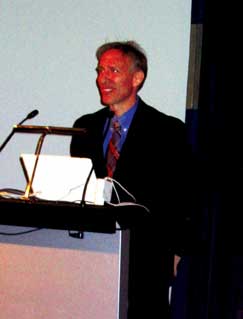 |
| Immediate Past President of the IEEE
EMC Society, Todd Hubing of the University of Missouri at
Rolla, spoke at the opening ceremony. |
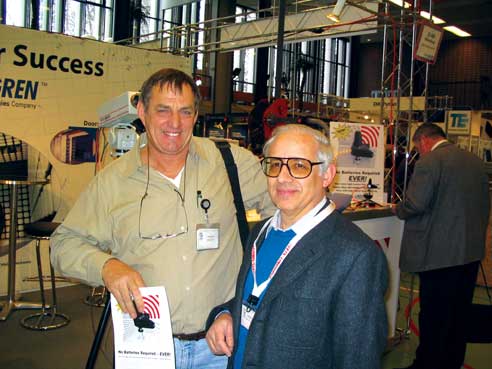 |
| Ken Hall of Hewlett Packard (left)
met with Paolo Corona of the Naval University of Naples during
EMC Zurich. |
 |
| Carl Baum of the Air Force Research
Lab (left) and John Norgard enjoyed a technical discussion
during EMC Zurich. |
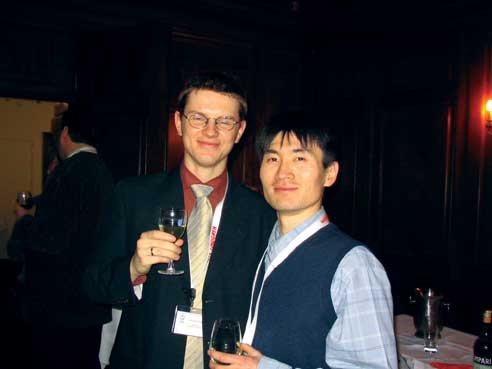 |
| Adam Tankielun of Fraunhofer Institute
in Germany (left) visited with Sungtek Kahng of the University
of Incheon in Korea. |
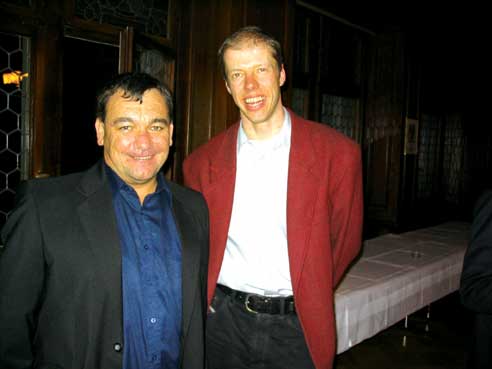 |
| Mark Bolsover of Boeing Australia
(left) and Markus Rothenhausler of EADS in Germany caught
up on aerospace developments during EMC Zurich. |
The first prize in the student paper competition
went to Italy, namely Fabio Pareschi, Luca Antonio De Michele,
Riccardo Rovatti and Gianluca Setti, for the paper titled “A
PLL-based clock generator with improved EMC”. Kia Wiklundh
from Sweden won the second prize for the paper on “Bandwidth
conversion of the amplitude probability distribution for emission
requirements of pulse modulated interference”. The third
prize went to S. Battermann and H. Garbe from the University of
Hannover in Germany for the paper titled “Sensitivity of
a short-wave receiving station regarding PLC transmission.”
The associated prize money was 1000, 750 and 500 Swiss Francs,
respectively. For the student paper competition, a total of 39
papers were submitted. In addition to the regular presentation
in their respective symposium sessions, the student papers were
also presented as posters in the interactive forum. The jury consisting
of Prof. R. Olsen, Dr. W. Radasky, Prof. K. H. Gonschorek, and
Dr. P. Leuchtmann selected the winners.
The exhibition this year was organized by Gerotron Communication
GmbH in the gymnasium of the ETH, which provided the 39 exhibitors
with about 1000 m2 of space on one floor. Although the number
of exhibitors was larger than two years ago, this number is still
too small to help keep the attendance fee low. This problem needs
to be addressed if EMC Zurich wants to maintain the exhibition
as a viable link between the ivory tower and the real world.
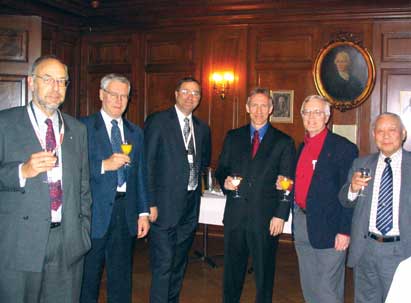 |
| Shown enjoying a social event following
EMC Zurich are (from left) Mike Marcus, Keynote Speaker at
the opening ceremony, Dan Hoolihan of Hoolihan EMC Consulting,
Barry Wallen of Dell, Todd Hubing, Bob Olsen, and Takeo Yoshino.
|
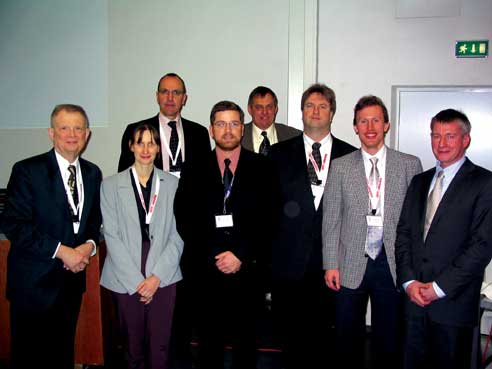 |
| Speakers gathered following the workshop
on “Advances in Site Validation Techniques above 1 GHz”
including (from left) Don Heirman of Don HEIRMAN Consultants,
Angela Nothofer from the National Physical Laboratory, Pierre
Beeckman of Philips, Clark Vitek of Extreme Networks, Ken
Hall of Hewlett Packard, Michael Foegelle of ETS-Lindgren,
Alexander Kriz of ARC Seibersdorf Research, and Dieter Schwarzbeck
of Schwarzbeck Mess-Elektronik. |
The social highlight was certainly the symposium banquet in the
Zurich Kongresshaus with nice entertainment, good food and wine.
Other social events included the wine tasting party on Monday
evening, the welcome reception in the exhibition hall on Tuesday,
the poster apéro as a side event of the interactive forum
on Wednesday noon and the farewell party on Thursday.
The 15% increase in the attendance rate of EMC Zurich ’05
shows that it was an overall success with many excellent presentations,
many interesting stories told, and many interesting ideas exchanged.
It is now time to look forward to EMC Zurich ’06 in Singapore
(www.emc-zurich.org),
which will take place in the dynamically evolving South-East Asian
region and underlines the ambition of EMC Zurich to maintain and
even enlarge its truly international character. EMC
|
|
|
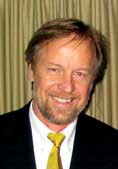 EMC
Week in Zurich
EMC
Week in Zurich















